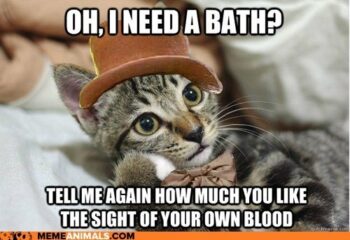In my zeal to try to help you deal with cat allergies, I find I’ve published two posts about the problem, and suggestions as to how to deal with them. You may go here and here to read them. Now I’ll provide information on the best cat breeds for people with allergies.
The information already posted on this website covers how to deal with your allergy to these furry creatures. You will learn the basics about the causes of these allergies and how best to handle them.
The cause of cat allergies can not be blamed on the fur. Rather, you can develop such an allergy if you are overly sensitive to proteins such as Fel D 1, found in saliva, urine, or dead skin cells. Stay away from cat dander! Three out of ten people in the United States have a cat allergy.
You will find no such thing as a truly hypoallergenic cat. However, if you don’t have a severe allergy, you may find the breeds described here tolerable, if you do all you can to minimize your reaction.
In my research, I’ve found the seven breeds, plus a couple of related “bonus breeds” that most sources list as the best breed to try. Read on to learn more about these breeds.
1) RUSSIAN BLUE
Oh, I’m not allergic, fortunately, but would love to have one of these cats. I’m fascinated by the idea
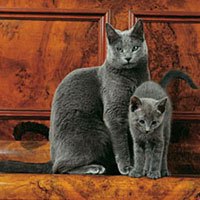
that they have such a thick coat that you can make indentations in the fur with your fingers and when you remove your hand, the pattern will remain.
Even with thick fur that has two coats, this cat sheds very little. The fur actually looks thicker because it sits at a 45-degree angle on their body. Thus, it looks fuller than other cats who have flat hair.
Most important, the Russian Blue has less of the Fel D 1 protein and less dander. These are the two agents responsible for your allergic reactions.
Fur color ranges from light silver to dark grey. The Russian Blue has a black hair gene that, diluted, gives the appearance of a blue color. Their striking green eyes furnish another unique feature
The cat, quiet and reserved, still loves spending time with his two-legged partner.
2) SPHYNX
Though the Sphynx has a reputation for hairlessness, the cat actually has a fine, downy fuzz. When stroked, this fuzz feels almost suede-like.
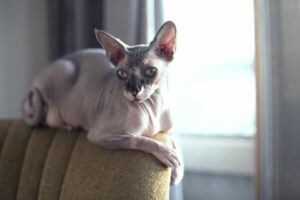
The Sphynx’s significant lack of fur makes it a great option for allergy sufferers. You can see that the allergenic proteins can’t get trapped in the fur since they have so little of it.
Not only does the Sphynx have very little fur, but it will produce less dander than other cats. However, the cat requires frequent bathing to remove body oils.
Despite their unusual look, these cats are sociable and loving. This energetic cat loves to show off for attention. It’s known to be very loyal and might like to follow you around.
Without much fur, the Sphynx prefers a warm area. Find sunny spots where this cat can hang out.
3) SIBERIAN
This cat comes with a full, luxurious coat. The Siberian Forest Cat sheds minimally, despite that long coat. Even with a long, three-layered coat, the cat does not require more grooming than other
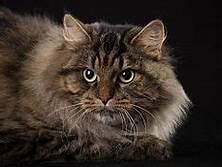
cats because its fur is glossy.
Though relatively rare in the United States, the Siberian probably originated 1,000 years ago in the Siberian forest of Russia. The cat actually holds the title of the national cat of Russia.
This breed apparently produces less of the Fel D 1 allergen compared to other cats. Weekly brushing will take care of grooming, even with a very thick coat. It does not tend to mat or tangle.
The cat has high energy and likes adventure. Its wonderful disposition makes it friendly with other cats, dogs, and children.
Even with all that fur, the Siberian has less dander, sheds much less, and produces lower Fel D 1 levels than other breeds.
4) SIAMESE (Alternate Choice: BALINESE)
Since Siamese cats have short fur, they shed significantly less than other breeds. They also shed less of the Fel D 1 protein. Their sleek fur traps the protein, minimizing its release into the atmosphere.
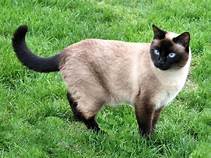
The very vocal Siamese likes to socialize. The kitty will provide you with an intelligent and affectionate companion.
If you really like the Siamese look but prefer a long-haired cat, you might pick out a Balinese. This cat looks like a Siamese, only with long fur.
Because the long coat grows only in a single layer, it does not shed much. Therefore, it does not produce as much dander. This breed also produces less of the Fel D 1 protein.
5) CORNISH REX (Also consider the DEVON REX or SELKIRK REX.)
The unique coat of the Cornish Rex has short, wavy fur. Sometimes this coat appears curly. Like in
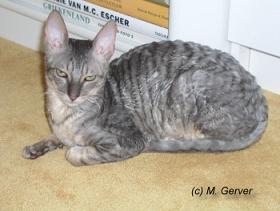
human hair, curly hair tends to bind together, making shedding hair fall out less frequently. Also, the cat has an extremely fine undercoat and no top coat.
Because these Cornish Rex cats shed less, they may well produce less dander than other breeds. Like the Sphynx cats, this breed requires frequent bathing in order to remove excess oil from the skin. The combination of a lack of shedding and frequent bathing reduces the build-up of dander and saliva on these cats’ coats.
Sometimes folks call this breed the greyhound of cats, because of its sleek appearance and galloping run. This adventurous cat tends to stay playful all its life.
You might consider one of these two Rex breeds as well — the DEVON REX and the SELKIRK REX. All three breeds have the curly coat, which indicates minimal shedding.
The Devon Rex’s lightweight coat has hair that grows in curls and waves like a poodle. They have a
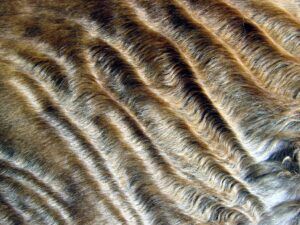
coat of soft down, with very little hair as a top coat. Thus, they don’t shed much and therefore don’t release as much of the dangerous saliva-coated particles into the air.
This cat requires little maintenance. Bathing does not have to be done frequently. Cleaning paws and ears will suffice.
Another wavy/curly-haired cat, the Selkirk Rex, might make a good choice if you have allergies. Its wavy/curly fur feels almost plush-like, as the fur grows soft and thick.
6) JAVANESE
Another one of the best breeds for allergy sufferers, the Javanese has only a single coat layer. The
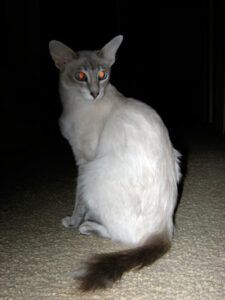
fine coat indicates minimal shedding; thus it spreads fewer allergens.
Unlike other breeds, these cats shed simply to replace fur. They do not shed seasonally as do many
other breeds. Because of the lack of undercoat, they don’t shed much and require only a weekly brushing.
This cat, like the Siamese, has great communication skills. Intelligent and curious, the cat also has a high energy level.
The Javanese came about because breeders wanted a cat with the qualities of the Siamese, but with an altered coat look.
7) ORIENTAL SHORTHAIR
Here we have another member of the Siamese family. This breed developed from a cross between a Siamese, Abyssinian, and either an American Shorthair, British Shorthair, or Russian Blue.
Because of these breeding variations, this cat has the largest range of physical characteristics of all cat breeds. It can be found in any of 300 colors and patterns.
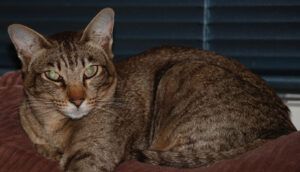
Their short, fine coat does not shed often. They require brushing a couple of times a week. You can also rub them with a damp cloth to help remove dead hair and dander, thus minimizing allergens.
Like their Siamese relative, this cat can be extremely talkative. They tend to become very attached to their owners and love getting lots of attention. They can become jealous or territorial regarding their humans.
Though no cat breed is scientifically hypoallergenic, one of these breeds might work for you if you have only a mild allergy. Be sure to click on the other two articles on how to deal with cat allergies, as you may find some helpful hints. (Links appear in the first paragraph.)
References I used for this post:
spotpetins.com/the-best-cats-for-allergies-6-non-shedding-cat-breeds/
thepurringjournal.com/blog/the-best-cat-breeds-for-people-with-allergies/

